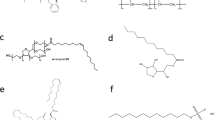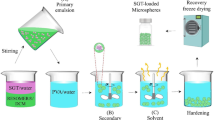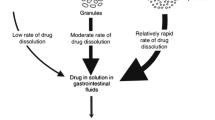Abstract
Adhesive and cohesive properties of chlorpromazine hydrochloride (CP) crystals were modified to improve their powder processing, e.g., direct tabletting and microencapsulation, by agglomeration. Moreover, sustained-released gelling microcapsules of CP were devised to prolong the pharmacological effect. The spherical crystallization technique was applied to prepare agglomerates for direct tabletting and microencapsulation to use them as core materials. The ethanolic solution dissolving CP was poured into a stirred cyclohexane, yielding spherically agglomerated crystals. The resultant agglomerates were free-flowing and easily packable spheres with average diameters of 200 to 1000 µm. The agglomerates reserved the high compressibility of the original powder having a small particle size (14 µm). The compression behavior represented by Heckel’s equation suggested that the agglomerates were disintegrated to individual primary crystals at low compression pressures, and then they were closely repacked and plastically deformed at higher pressures. After agglomeration, microencapsulation was continuously performed in the same batch by a phase separation method. Coacervate droplets produced by pouring cyclohexane into a dichloromethane solution, dissolving poly vinyl acetate as a coating polymer, were added to the crystallization system under stirring, to prepare the microcapsules. By filling the microcapsules in gelatin hard capsules or tabletting them, their drug release rates became retarded compared with the physical mixture treated in the same way, having the same formulation as the microcapsules. This phenomenon was due to the gelation of poly vinyl acetate of the microcapsules in the dissolution medium, whose glass transition temperature is very low. This novel sustained-release dosage form is termed “gelled microcapsules.”
Similar content being viewed by others
REFERENCES
P. M. John, H. Minatoya, and F. J. Rosengerg. Microencapsulation of bitolterol for controlled release and its effect on bronchodilator and heart rate activities in dogs. J. Pharm. Sci. 68:475–481 (1979).
Y. Kawashima, M. Okumura, and H. Takenaka. Spherical crystallization: Direct spherical agglomeration of salicylic acid crystals during crystallization. Science 216:1127–1128 (1982).
Y. Kawashima, S. Aoki, H. Takenaka, and Y. Miyake. Preparation of spherically agglomerated crystals of aminophylline. J. Pharm. Sci. 73:1407–1410 (1984).
A. Sano, T. Kuriki, T. Handa, H. Takenaka, and Y. Kawashima. Particle design of tolbutamide in the presence of soluble polymer or surfactant by the spherical crystallization technique: Improvement of dissolution rate. J. Pharm. Sci. 76:471–474 (1987).
Y. Kawashima, T. Niwa, T. Handa, H. Takeuchi, T. Iwamoto, and Y. Itoh. Preparation of controlled-release microspheres of ibuprofen with acrylic polymers by a novel quasi-emulsion solvent diffusion method. J. Pharm. Sci. 78:68–72 (1989).
Y. Kawashima, T. Niwa, H. Takeuchi, T. Hino, and Y. Itoh. Hollow microspheres for use as a floating controlled drug delivery system in the stomach. J. Pharm. Sci. 81:135–140 (1992).
K. Kawakita and K. H. Lüdde. Some considerations on powder compression equations. Powder Technol. 4:61–68 (1970/1971).
H. Kuno. In T. Kubo, G. Jimbo, E. Saito, H. Takahashi, and S. Hayakawa (eds.), Powder (Theory and Application), Chap. 5, Maruzen, Tokyo, 1979, pp. 341–346.
J. T. Fell and J. M. Newton. Determination of tablet strength by the diametral-compression test. J. Pharm. Sci. 59:688–691 (1970).
R. W. Heckel. Density-pressure relationships in powder compaction. Trans. Met. Soc. AIME 221:671–675 (1961).
R. W. Heckel. An analysis of powder compaction phenomena. Trans. Met. Soc. AIME 221:1001–1008 (1961).
M. Samejima and G. Hirata. Japanese Patent 1408282 (1987).
R. W. Korsmeyer and N. A. Peppas. Macromolecular and modeling aspects of swelling-controlled systems. In T. J. Roseman and S. Z. Mansdorf (eds.), Controlled Release Delivery Systems, Marcel Dekker, New York and Basel, 1983, pp. 85–86.
Author information
Authors and Affiliations
Rights and permissions
About this article
Cite this article
Niwa, T., Takeuchi, H., Hino, T. et al. Preparation of Agglomerated Crystals for Direct Tabletting and Microencapsulation by the Spherical Crystallization Technique with a Continuous System. Pharm Res 11, 478–484 (1994). https://doi.org/10.1023/A:1018993927582
Issue Date:
DOI: https://doi.org/10.1023/A:1018993927582




